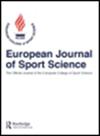通过身体成分、腹肌功能和自律神经活动的积极变化,平板支撑运动可提高呼吸能力
IF 2.4
3区 医学
Q2 SPORT SCIENCES
引用次数: 0
摘要
本研究旨在探讨平板运动训练(PET)对呼吸功能、身体成分、腹肌表现和自律神经系统(ANS)的影响。61名年轻人参加了实验,并被分为对照组(CG,n = 31)和运动组(EG,n = 30),每周进行3天平板运动训练,为期12周。实验结束后,对照组的身体成分有所下降,而运动组的身体成分有所改善(P < 0.001)。EG 的平均最大位移量减少了 34%,腹肌平均收缩时间增加了 20%。在 EG 中,仰卧起坐显著增加了 55%。在 EG 中,峰值呼气力大幅增加了 24%,1 秒内用力呼气量增加了 14%,同时静息呼吸频率降低了 9%。与 CG 相比,两组之间的这些变化具有显著性(P = 0.001)。在 EG 中,静息心率显著降低了 2%,交感神经活动降低了 5%,副交感神经活动增加了 5%。与 CG 相比,两组之间的这些变化具有显著性(P = 0.001)。这项研究的结果表明,在控制饮食摄入和体育锻炼的情况下,在年轻人中实施 PET 可使呼吸能力发生显著变化。在发生这些变化的同时,身体成分、腹部功能和自律神经系统也得到了改善。本文章由计算机程序翻译,如有差异,请以英文原文为准。
Plank exercise improves respiratory capacity through positive changes in body composition, abdominis function, and autonomic nerves' activities
This research aimed to explore the impact of plank exercise training (PET) on respiratory function, body composition, abdominis performance, and autonomic nervous system (ANS). Sixty‐one young adults participated and were divided into a control group (CG, n = 31) and an exercise group (EG, n = 30), wherein PET was administered 3 days per week for 12 weeks. After the experiment, the body composition of the CG deteriorated, whereas that of the EG improved (p < 0.001). The EG exhibited a reduction of ∼34% in the mean maximum displacement and a rise of ∼20% in the mean contraction time of the abdominis. The sit‐up in the EG demonstrated a significant increase of ∼55%. In the EG, there was a substantial increase in peak expiratory force by ∼24% and forced expiratory volume in 1 s by ∼14%, accompanied by a reduction in resting respiratory rate by ∼ −9%. When compared to the CG, these alterations were significant between the two groups (p = 0.001). In the EG, there was a significant decrease in resting heart rate by ∼2%, accompanied by a decrease in sympathetic nervous activity by ∼ −5% and by an increase in parasympathetic nervous activity by ∼5%. When compared to the CG, these alterations were significant between the two groups (p = 0.001). The findings of this study revealed that implementing PET in young adults, while controlling for dietary intake and physical activity, resulted in noteworthy changes in respiratory capacity. These changes were coupled with improvements in body composition, abdominal functions, and the ANS.
求助全文
通过发布文献求助,成功后即可免费获取论文全文。
去求助
来源期刊
CiteScore
6.60
自引率
3.10%
发文量
153
审稿时长
6-12 weeks
期刊介绍:
The European Journal of Sport Science (EJSS) is the official Medline- and Thomson Reuters-listed journal of the European College of Sport Science. The editorial policy of the Journal pursues the multi-disciplinary aims of the College: to promote the highest standards of scientific study and scholarship in respect of the following fields: (a) Applied Sport Sciences; (b) Biomechanics and Motor Control; c) Physiology and Nutrition; (d) Psychology, Social Sciences and Humanities and (e) Sports and Exercise Medicine and Health.

 求助内容:
求助内容: 应助结果提醒方式:
应助结果提醒方式:


